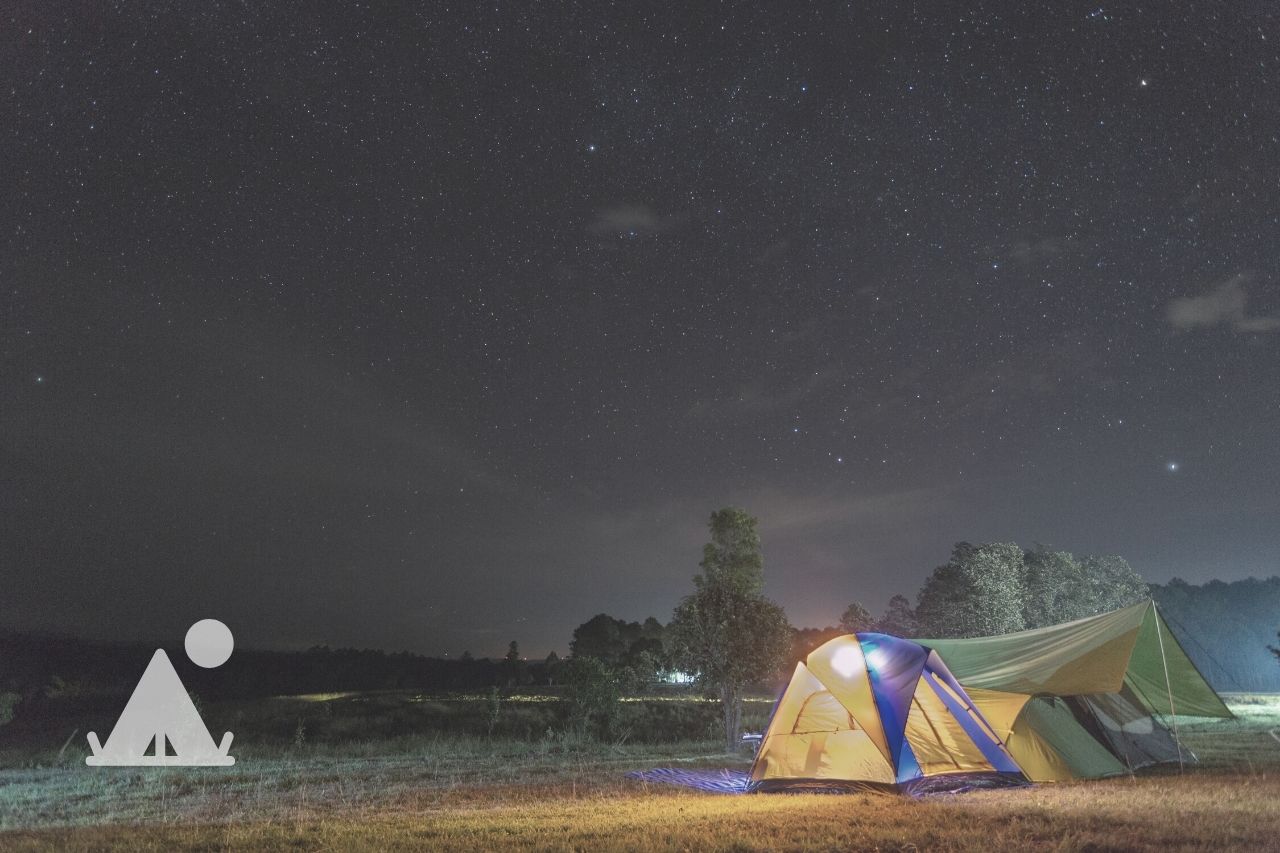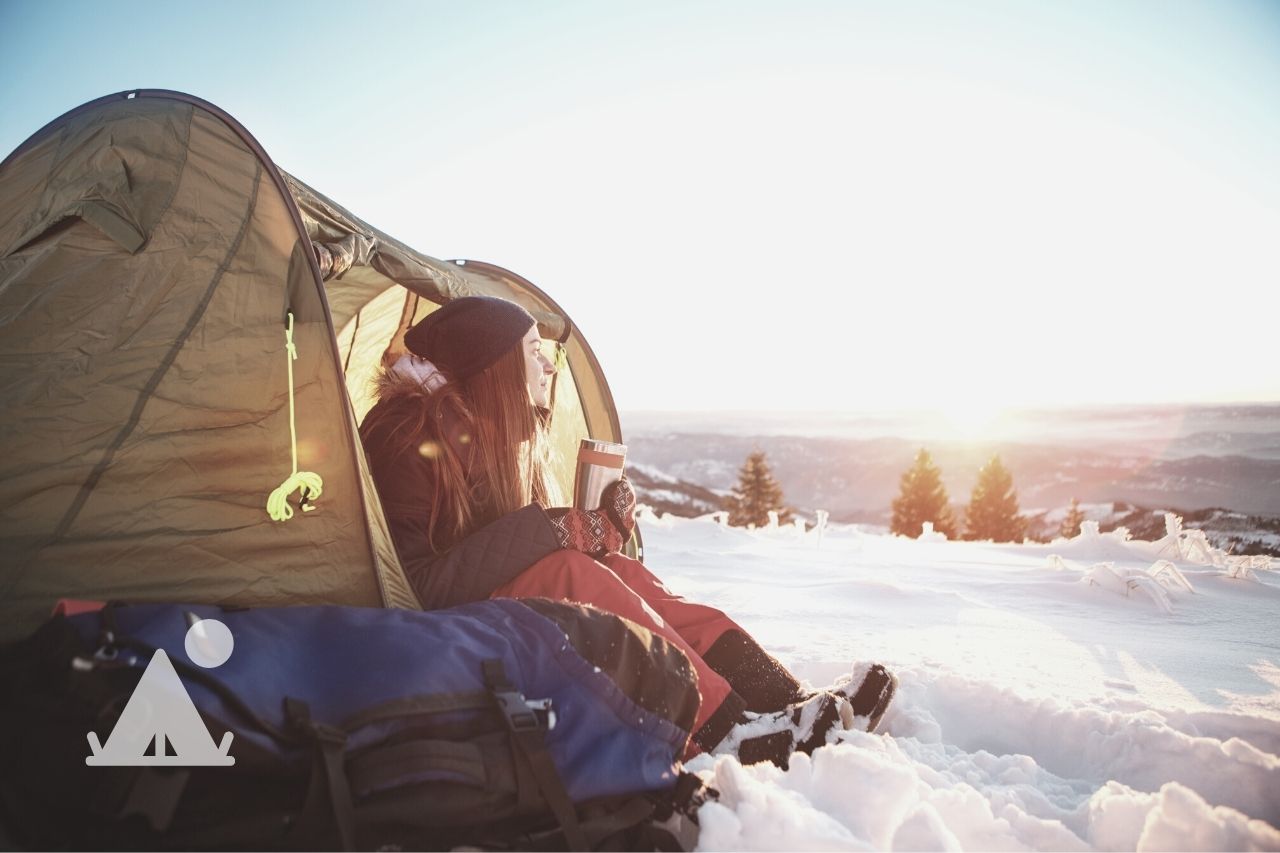Winter camping comes with unexpected challenges from frozen drinking water to car door locks refusing to open. In this post, we talk about one of the biggest challenges – sleeping warm. Specifically, we explain how to insulate a tent for winter camping and other tips to stay warm.
Can I Use a Regular Tent For Winter Camping?

Unless you expect to camp in a blizzard or extreme cold and wind, a regular 3-season tent is adequate for most winter camping adventures.
It’s waterproof, can withstand strong winds, and provides a good balance between ventilation and insulation.
However, if you expect some serious snow or you just want to be ready for anything, get a 4-season tent.
4-season tents, also called winter tents, can withstand heavier snow loads and strong winds. They also feature less mesh and more solid canopy fabric for improved heat retention inside the tent.
That said, do not rely mostly on your tent for insulation. Tents are great at keeping snow, wind, and rain out. They are, however, not designed to protect you completely from the cold.
Experienced cold weather campers know the best way to stay warm in a tent is to cocoon yourself in warm stuff.
The best insulation is the one that’s right next to your body. This includes the right sleeping bag (or quilt), a ground tap, and a sleeping pad.
How To Insulate The Ground Under Your Tent?
Most of the heat in your tent will be lost through the ground. That’s because the ground is cold during winter, and could even be covered with snow.
The ground under your tent is the most important area to insulate when winter camping. That’s especially important when you consider that it’s the area closest to your body when sleeping.
The first step is to clear any snow on the ground before pitching your tent. Sleeping on snow will make you colder. The snow can also melt from your body heat and refreeze, forming uncomfortable bumps under you.
But if the ground is packed hard with snow and ice, you’ll just have to sleep on it and insulate your tent as best as you can.
Here are some additional tips for insulating the ground.
- Lay a waterproof tarp on the ground. Get a tarp that’s a bit bigger than your tent’s footprint and then fold the edges against the inside walls of your tent to cover the gap between the ground and the bottom of your tent. This keeps cold air from getting in. Here’s a video showing how to do it.
- If you don’t have a tarp, any insulative material will do, like a thick blanket, a large towel, or reflective insulation such as this one, or an emergency survival blanket.
- Sleep on an inflatable or self-inflating pad. Having a layer of trapped air between you and the ground makes for excellent insulation. Air is a great insulator. It absorbs your body heat and retains it. Even if you have a sleep bag, lay it on a pad.
- Use natural insulation. If there are dead leaves on the ground, gather them and pitch your tent on them. Just make sure they are dry and there aren’t any sharp objects hiding in the leaves. The air trapped between the leaves provides great insulation.
How To Insulate The Walls Of Your Tent?
If you have a 4-season tent, you probably don’t need to insulate it at all. As long as you have a warm sleeping bag or quilt, and dress warmly, you should be good.
But if you have a less insulative tent or expect very low temperatures, insulating the walls can help improve heat retention inside the tent.
Just make sure there’s still sufficient ventilation for breathing and to prevent condensation.
There aren’t any products – at least none that we found – designed specifically for insulating tent walls.
The best solution is the reflective aluminum foil insulation that’s used in homes. Cut the insulation to size and then tape it against the inside of your tent walls and roof.
Reflective insulation works by reflecting almost all the heat that falls on it. As your body produces heat, it’s reflected back into the tent instead of escaping outside.
How To Stay Warm When Winter Camping?
In addition to insulating the tent walls and ground, it’s also crucial to keep your body warm. Here are tips on how to accomplish this.
- Choose the right sleeping bag or quilt. Whether you choose a synthetic or down sleeping bag, make sure it’s rated for the temperature you are going to be camping in.
- Dress in layers starting with bottom layers such as thermal underwear, mid layers, and thick outer layers such as a jacket. Don’t forget a thick pair of socks. Layering provides better insulation and makes it easy to adjust your layering as it gets warmer or colder.
- Strip down to the base layers before you get into your sleeping bag. This will keep you warm without making you sweat. Sweating too much will make you colder and reduce your sleeping bag’s insulation power.
- A sleeping pad is better than a raised cot. A cot leaves space underneath for cold air to move about and take away warmth. Moving air is not good for insulation.
- Choose the smallest tent possible. Don’t use a 4-person tent if you are just two people. A smaller tent is easier to keep warm. In most cases, just your body heat is enough to warm up the tent as long as you’ve insulated the tent.
- Cover your head to prevent body heat loss. If your sleeping bag’s hoodie doesn’t adequately cover your head, layer on additional covering like a balaclava that covers your head, neck and part of your face.
- Use two sleeping pads for double insulation. Don’t forget to get sleeping pads with a high R value (4 or higher). The higher the R value, the better the insulation.
- If it’s very cold, consider adding a heat source to your tent. Safe heating ideas include an electric space heater, an electric pad or blanket, a hot water bottle, or a portable propane heater. Do not use a camping stove to heat your tent. It doesn’t have the safety features most camping heaters come with.
- Make sure you are well fed. A high-protein meal is especially good for keeping your core temperature high. It’s also essential to stay hydrated.
How To Protect Your Tent From Wind and Snow When Winter camping?

Strong winds will not only threaten to blow away your tent, they also bring cold temperatures with them.
So it’s important that you choose the right location to pitch your tent.
You want to avoid open exposed areas like the beach, an open grassland or the top of a cliff.
Look for a location that provides a natural windbrake using trees, rocks, or bushes. You’ll sleep much warmer and without worrying about strong winds.
You can also make a natural windbreak by building a wall of snow around your tent. Use a shovel to collect and compacts now into a 2-3 foot high wall.
If there isn’t enough natural windbreak, you can make your own using a camping tarp. Tie the top of the tap between two trees and peg the bottom to the ground such that the tarp slopes outwards.
This allows wind to blow up and over your tent.
As for snow protection, a good quality 4-season tent should be able to handle significant snow load without damage or collapsing.
If you have a 3-season tent or just want to be extra-safe, pitch a rain fly or tarp over the tent. Make sure the fly or tap is sloping so that snow slides off it.
Car vs. Tent Camping During Winter: Which is Warmer?
A car or truck might seem warmer than a tent when winter camping. After all, it’s thicker than the thin fabric of a tent.
In reality though, your car will not be automatically warmer than a tent. In fact, all that metal could likely result in a colder interior since heat is lost more easily.
As the night progresses and the little heat that was trapped in the seats and dashboard is lost, the car could get even colder.
Car/truck camping is great and has its benefits. But, similar to tent camping, you’ll still need to think about insulation.
In many cases, having a high R-value sleeping pad, a low degree sleeping bag, and warm wear is enough to keep you warm in the back of your vehicle.
But if you often camp in extreme cold situations, you’ll need additional sources of heat like an electric heater or an electric blanket. You may also need to insulate the inside of the car.
You can have permanent insulation installed in the back of the truck, or tape reflective sheets all over the inside of the car to reflect back heat.
That said, a vehicle has one big advantage over a tent when it comes to winter camping – it provides excellent protection from wind and snow. You could comfortably camp out during a blizzard.